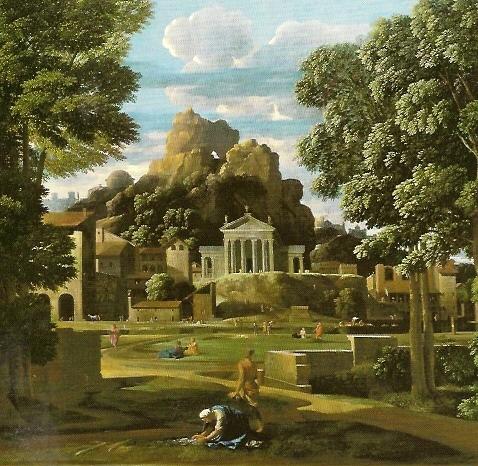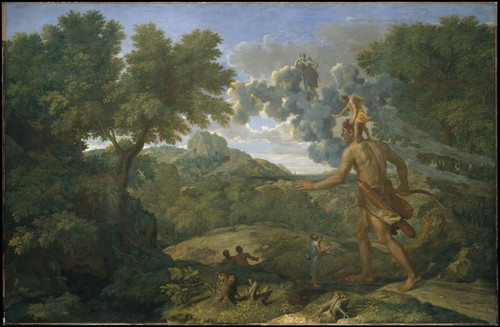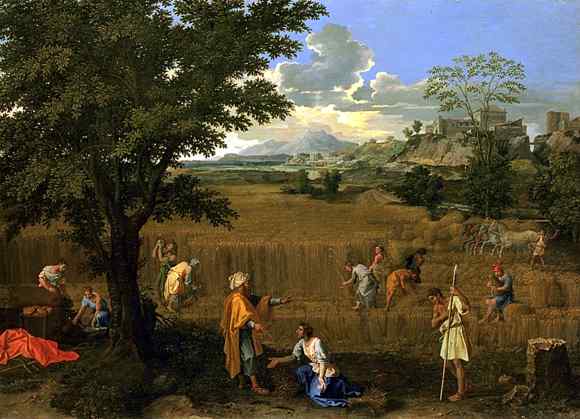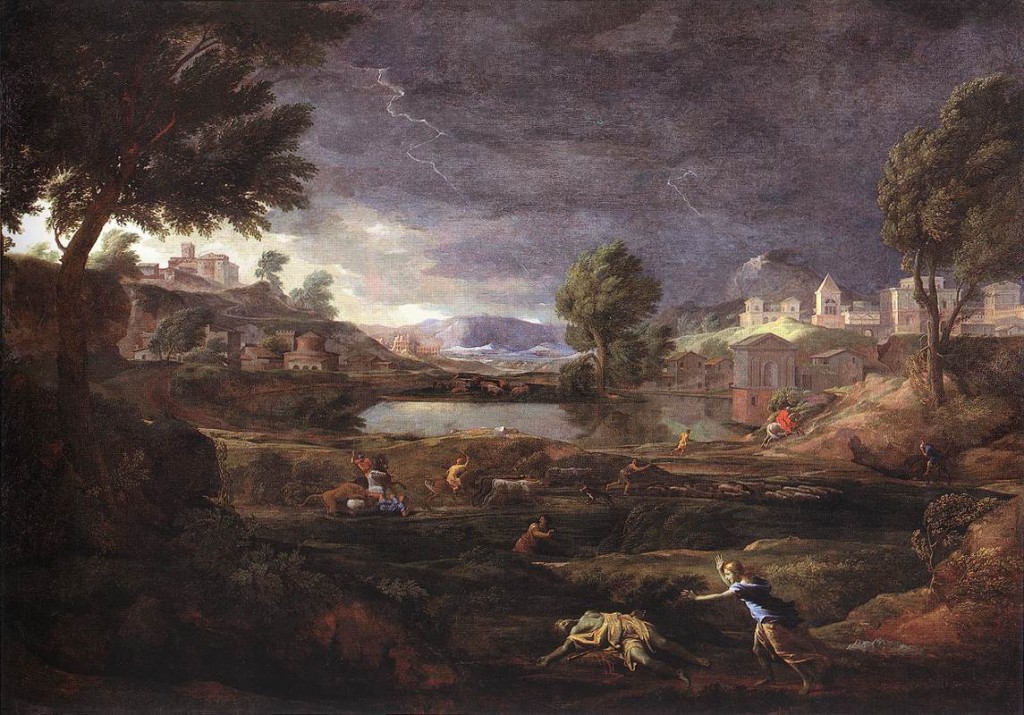Nicolas Poussin’s work is full of conflicting tendencies. More exactly, with tendencies that ought to be conflicting and that would be anywhere but in Poussin’s painting.
This many sidedness, these very contradictions, determine and explain his classicism. For classicism as Poussin demonstrates, is an effort to mediate between divergent and even antagonistic forces. It is a hard won equilibrium, unstable as that of a tightrope walker, a precise, pinpoint, juggler’s balance. Like the spheres which Poussin in his pictures if fond of balancing on top of columns and obelisks. It is this tension that differentiates Poussin’s classicism from the baroque as well as from the sheer academic.

---Ernst Gombrich traced the rise of pure landscape painting.Without mentioning Poussin, he identified the way in which the creation of this novel genre required a new public, "the consumer of collector, who creates the demand." Poussin, Christiansen is suggesting, responds to that demand. What is a pure landscape painting? If Constable is our model, as he is Gombrich’s model in Art and Illusion, then a landscape is a painting in which any human figures are mere adjuncts to nature herself. Farmers, mill workers or shepherds can appear, but not identifiable people. So, for example, paintings showing Hannibal crossing the Alps or Goethe meditating in the Campagna cannot be pure landscapes. To put this distinction another way, a history painting and even a portrait of Goethe can only be fully understood by reference to some text identifying the people present. But a pure landscape merely shows an attractive or stormy countryside because its farmers, mill workers and shepherds are not identifiable individuals. Landscape painting is a purely aesthetic genre. Read More:http://journal.utarts.com/articles.php?id=17&type=paper image:http://www.louvre.fr/llv/oeuvres/detail_notice.jsp?CONTENT%3C%3Ecnt_id=10134198673225746&CURRENT_LLV_NOTICE%3C%3Ecnt_id=10134198673225746&FOLDER%3C%3Efolder_id=9852723696500815&baseIndex=50&bmLocale=en
For one could say that the classic is an unstable equilibrium, whereas the baroque is all instability and the academic is all just equilibrium. The baroque is one sided, though it carries that side to its magnificent extreme. The academic regards as an end the formulas worked out by the classic to master the chaos of contradictory tendencies; the two are about as alike as a Mozart sonata played by Johnny Rotten and by a mechanical piano.

---Artist Nicolas Poussin (French, Les Andelys 1594–1665 Rome) TitleBlind Orion Searching for the Rising Sun Date1658 MediumOil on canvas--- Read More:http://www.metmuseum.org/works_of_art/collection_database/european_paintings/blind_orion_searching_for_the_rising_sun_nicolas_poussin/objectview_enlarge.aspx?page=32&sort=0&sortdir=asc&keyword=&fp=1&dd1=11&dd2=0&vw=1&collID=11&OID=110001774&vT=1&hi=0&ov=0
Like the casual smile on the tightrope walker’s lips, Poussin’s seemingly effortless poise on the divide of several artistic worlds contains a lesson of courage. It is one particularly appropriate today, when the most gifted painters cultivate a specialty and abandon themselves to a single course rather than face up to the difficulty of being caught between conflicting, equally powerful poles. Poussin accepts the duality.
He formulates it in the background of his Self Portrait: nicolaus poussinus andelyensis academicus romanus, the inscription begins. Les Andelys, a little Normandy village overlooking the river Seine, where they grow wheat and apples; Rome, the cultural capital of Christendom. These places mark the poles of his life and work. Les Andelys/Rome. Peasant and Poet.

---Christiansen calls Poussin the landscape painter a "proto-romantic.I would put this point in a stronger way. Once Constable’s pure landscapes appeared, Clement Greenberg’s modernist separation of literature from visual art was in the wings. Ambitious painting no longer needed to ally itself with texts. Of course, visual modernism did not only involve landscape painting. More often, in fact, it was associated with Baudelairian urban subjects. But once this genre was developed, then the way was open to thinking in formalist terms that a significant painting’s subject was essentially irrelevant to judging its aesthetic value. As I reconstruct Christiansen’s concerns, one goal is to make Poussin acceptable to contemporary taste by focusing on the landscapes. In the nineteenth century, two very different Poussins appear, the history painter and "a painter of nature whose works could be appreciated with little or no literary knowledge."---Read More:http://journal.utarts.com/articles.php?id=17&type=paper
Poussin was born in 1594 to a father soldier turned farmer and a mother of the petit bourgeoisie. His parents were always hostile to his painterly ambitions and he eventually left clandestinely for Paris in 1612. But, Paris at that time was far from an artistic capital, more a provincial backwash of the arts. When the Queen, Marie de Medicis required an artist of stature to decorate her new mansion, the go-to man, the Flemish Rubens was summoned. The Renaissance, abruptly imported from Florence to Fontainbleu, had interrupted a flourishing national tradition. The French distorted it, diluted it, reduced it to ornamentalism and eclectic mannerism. The exigent Poussin could find little satisfaction in such a climate.
Poussin spent a bit of time in the studio of the mediocre Georges Lallemand and a few months with the uninspired Ferdinand Elle. A young nobleman offered him a room, board and plenty of walls to paint only to discover that the squire’s mother refused to see in him anything but a menial servant. Destitute, he painted his way back to Paris. He reached the city so starved, so completely exhausted that he was forced to return to Villers to restore his shaken health.

---...but the problem for Poussin scholarship is that we don’t know how to classify his pictures. Maybe there is more to his landscapes than meets the eye, but perhaps they are just attractive scenes. In the history paintings, Christ Healing the Blind for example, human figures are large and set in the foreground. But although the human figures in Landscape with Phramus and Thisbe, which the Metropolitan includes in "Poussin and Nature," are relatively small, you cannot understand that picture without knowing the story of Phramus and Thisbe. Christiansen claims that William Hazlitt’s account marks a fundamental shift in the way that Poussin was understood. Focusing on the landscapes, Hazlitt argues that Poussin was among painters (more than any one else) what Milton was among poets. There is in both something of the
pedantry, the same stiffness, the same elevation, the same grandeur, the same mixture of art and nature, the same richness of borrowed materials, the same unity of character....Read More:http://journal.utarts.com/articles.php?id=17&type=paper image:http://en.wikipedia.org/wiki/File:Nicolas_Poussin_-_Stormy_Landscape_with_Pyramus_and_Thisbe_-_WGA18334.jpg
After a year Poussin went back to Paris, no doubt convinced that it could be for him little more than a stepping stone. Seriousness and perseverance were already his dominant traits. Much later, when someone asked him to what cause he attributed his ranking among the most illustrious painters of the times, he replied, ” I neglected nothing.” Others around him might be satisfied with halfway solutions and shabby substitutes; Poussin wanted to go to the source. And the source at that time was Rome.
to be continued….
ADDENDUM:
Commentary on Poussin poses questions about truth in interpretation in especially pointed form. His correspondence says much about his art.[6] And in his century, elaborate accounts appeared. Because he is identified as the philosopher-painter, there is a tendency to assume that he was extremely erudite. Once Anthony Blunt offered influential highly complex accounts, other scholars, in response, offered still more elaborate interpretations.
When Poussin depicts a landscape, some commentators think that every person and architectural element must have a source in some written account. If he himself did not read a book, at least it could have been known to some learned colleague. (He was friendly with some Roman intellectuals.) Whatever Poussin depicts can, with ingenuity, be matched with some written commentary. But surely he could have depicted figures and a city in a landscape without reference to a text? With modernist art, we are accustomed to think that the painter might have invented his composition. Why, then, should we not give Poussin the same freedom? Why must his pictures always be controlled by some source? Once we recognize that any image can, with ingenuity, be linked with some appropriate text, then we should recognize that establishing word-image correlations is not illuminating. Within the older literature, this contrast was anticipated when Anthony Blunt and Denis Mahon compared concern with Poussin’s social and political context with interest in Poussin as a painter. Read More:http://journal.utarts.com/articles.php?id=17&type=paper







 COMMENTS
COMMENTS



